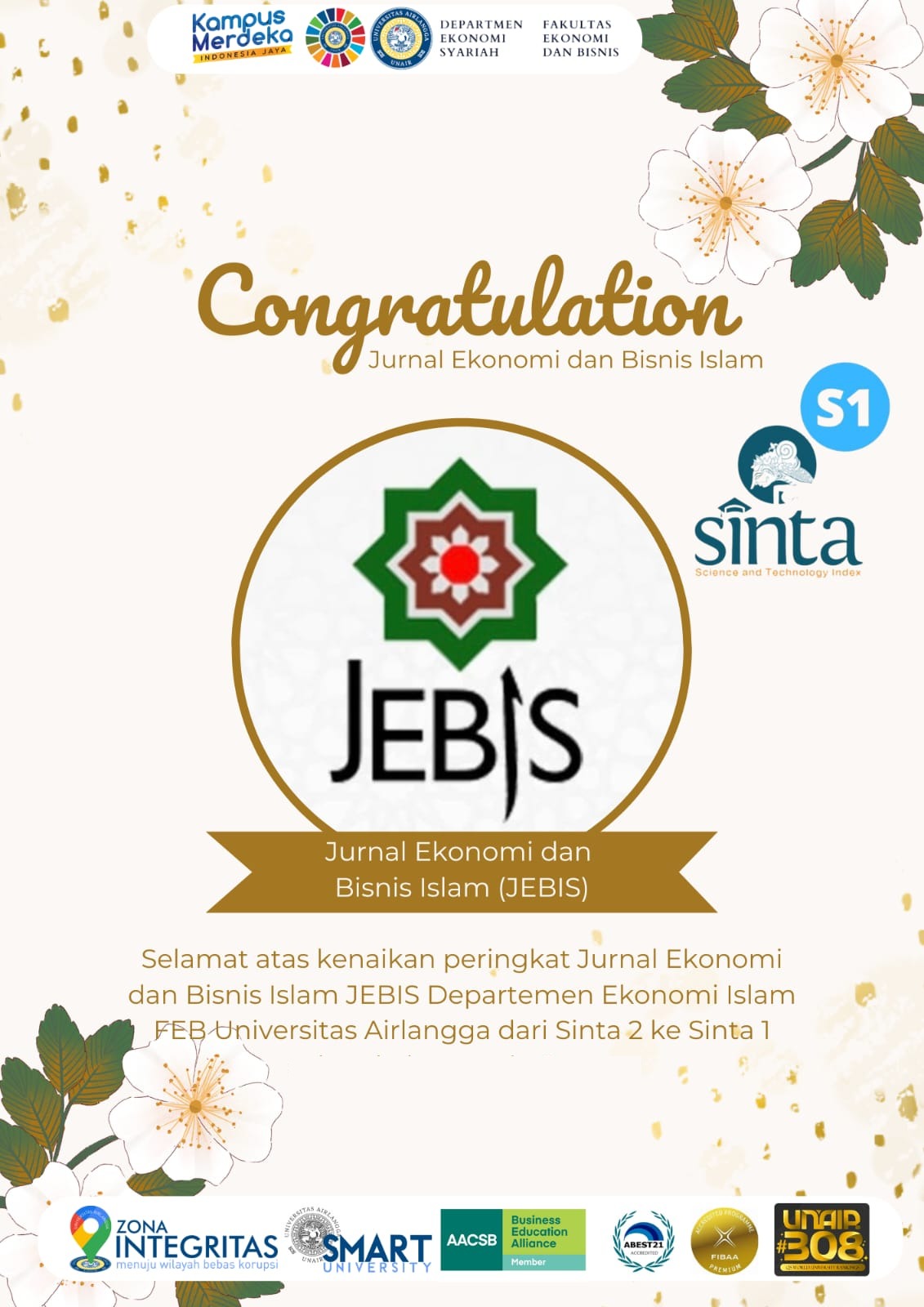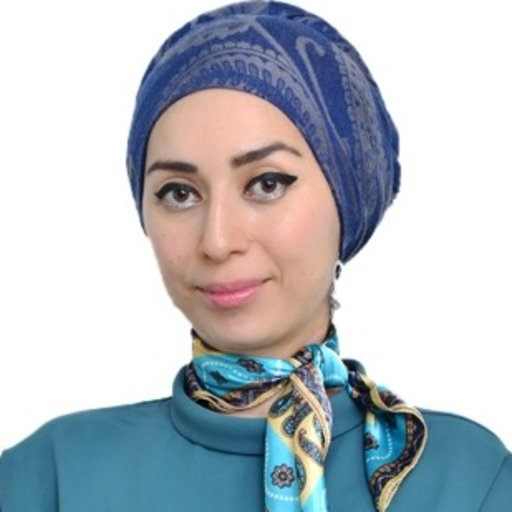ZAKAT, INFAQ, SADAQAH ON MUSTAHIK INCOME TO REALIZE NO POVERTY IN INDONESIAN ZAKAT INSTITUTION
Downloads
Abdelhady, H. (2012). Islamic Finance as a Mechanism for Bolstering Food Security in the Middle East: Food Security Waqf. Sustainable Development Law & Policy, 13(1), 29–35.
Abduh, M. (2019). The role of islamic social finance in achieving SDG number 2: End hunger, achieve food security and improved nutrition and promote sustainable agriculture. Al-Shajarah: Journal of the International Institute of Islamic Thought and Civilization, 2019(Special Issue Islamic Banking and Finance 2019), 185–206. https://journals.iium.edu.my/shajarah/index.php/shaj/article/view/902
Abdullah, M., & Sapiei, N. S. (2018). Do religiosity, gender and educational background influence zakat compliance? The case of Malaysia. International Journal of Social Economics, 45(8), 1250–1264. https://doi.org/10.1108/IJSE-03-2017-0091
Ahmed, B. O., Johari, F., & Wahab, K. A. (2017). Identifying the poor and the needy among the beneficiaries of zakat Need for a zakat-based poverty threshold in Nigeria. International Journal of Social Economics, 44(4), 446–458. https://doi.org/10.1108/IJSE-09-2015-0234
Akram, M., Mian, & Muhammad, A. (2014). Dynamic Role of Zakat in Alleviating Poverty: A Case Study of Pakistan. Munich Personal RePEc Archive.
Al-Arif, N. R. (2010). Teori makroekonomi Islam: konsep, teori, dan analisis. 295.
Ali, A. F. M., & Ibrahim, M. F. (2018). Determination of poverty among the poor and needy in a developing country. Islamic Research Journal of Emerging Economies & Islamic Research, 6(2), 47–61.
Ali, A. F. M., Noor, Z. M., Aziz, M. R. A., Ibrahim, M. F., & Johari, F. (2013). Impact of Zakat Distribution on Poor and Needy Recipients: An Analysis in Kelantan, Malaysia. Australian Journal of Basic and Applied Sciences, 7(13), 177–182. http://www.ajbasweb.com/old/ajbas_November_2013.html
Ali, D. M. (1988). Sistem Ekonomi Islam Zakat dan Wakaf. penerbit universitas indonesi (UI-Press).
Amalia, P. D. (2010). Peran Lembaga Amil zakat dalam Pemberdayaan Ekonomi masyarakat Miskin. Universitas Airlangga.
Amalia, R. Y., Nurwahidin, N., & Huda, N. (2020). Role of Zakat in Achieving Sustainable Development Goals (Sdgs) in Indonesia. International Journal of Zakat and Islamic Philanthropy, 2(2), 199–204.
Anik, A., & Prastiwi, I. E. (2019). Peran Zakat dalam Meningkatkan Pertumbuhan Ekonomi Melalui Pemerataan Equity. Proceeding Seminar Nasional & Call For Papers, September, 119–138.
Arif, A. H. (2016). Pengaruh Zakat Produktif Terhadap Pendapatan Keluarga Miskin (Studi Kasus Pada Lembaga Amil Zakat El-Zawa Universitas Islam Negeri Maulana Malik Ibrahim Malang). Jurnal Ilmiah Mahasiswa Fakultas Ekonomi Dan Bisnis, 4(2), 1–16.
Athoilah, M. A. (2018). The zakat effect on economic growth, unemployment, and poverty in the Island of Java: Panel data analysis 2011-2012. Ekspansi. Jurnal Ekonomi, Keuangan, Perbankan, Dan Akuntansi, 10(2), 205–230.
Ayuniyyah, Q., Pramanik, A. H., Md Saad, N., & Ariffin, M. I. (2022). The impact of zakat in poverty alleviation and income inequality reduction from the perspective of gender in West Java, Indonesia. International Journal of Islamic and Middle Eastern Finance and Management. https://doi.org/10.1108/IMEFM-08-2020-0403
Ayuniyyah, Q., Pramanik, A. H., Saad, N. M., & Ariffin, M. I. (2018). ZAKAT FOR POVERTY ALLEVIATION AND INCOME INEQUALITY REDUCTION: WEST JAVA, INDONESIA. Journal of Islamic Monetary Economics and Finance, 4(1), 85–100. https://doi.org/10.21098/JIMF.V4I1.767
Aziz, Y., Mansor, F., Waqar, S., & Haji Abdullah, L. (2020). The nexus between zakat and poverty reduction, is the effective utilization of zakat necessary for achieving SDGs: A multidimensional poverty index approach. Asian Social Work and Policy Review, 14(3), 235–247. https://doi.org/10.1111/aswp.12212
Badan Pusat Statistik. (2020). BPS.
BAZNAS. (2016). Buku Statistik Zakat Nasional. SIM dan Pelaporan.
Dembele, A., & Bulut, M. (2021). The Role of Social Finance in Achieving the Objectives of Sustainable Development Goals. Turkish Journal of Computer and Mathematics Education, 12(14), 3962–3976.
Efendi, M. S., & Fathurrohman, M. S. (2021). Dampak Zakat Terhadap Kesejahteraan Material Dan Spiritual Mustahik (Studi Kasus Baznas Microfinance Desa Sawojajar). Jurnal Ekonomi Syariah Teori Dan Terapan, 8(6), 686. https://doi.org/10.20473/VOL8ISS20216PP686-695
Hafiduddin, D. (2013). Analisis syariah tentang konsep kemiskinan. Paper Presented at the National Focus Group Discussion on Islamic Poverty Line, Bogor.
Hayakawa, H., & Venieris, Y. P. (2019). Duality in human capital accumulation and inequality in income distribution. Eurasian Economic Review, 9(3), 285–310. https://doi.org/10.1007/S40822-018-0110-8
Herianingrum, S., Ernayani, R., Seto, H., Rayandono, M. N. H., & Fauzy, M. Q. (2020). The Impact Of Zakat, Education Expenditure, And Health Expenditure Towards Poverty Reduction. In Systematic Reviews In Pharmacy. In Systematic Reviews in Pharmacy (Vol. 11, Issue 12).
Jaenudin, M., & Hamdan, A. (2022). Penilaian Dampak Zakat, Infak, Sedekah Terhadap Kemiskinan Spiritual Dan Material Penerima Manfaat Laznas LMI: Pendekatan CIBEST. Jurnal Ekonomi Syariah Teori Dan Terapan, 9(3), 362–378. https://doi.org/10.20473/vol9iss20223pp362-378
Johari, F., Fahme Mohd Ali, A., binti Mohd Noor, Z., Ridhwan Ab Aziz, M., & Faisol Ibrahim, M. (2013). Impact of Zakat Distribution on Poor and Needy Recipients: An Analysis in Kelantan, Malaysia. Australian Journal of Basic and Applied Sciences Malaysia. Aust. J. Basic & Appl. Sci, 7(713), 177–182.
Kahf, M. (1997). Potential Effects Of Zakat On Government Budget. In IIUM Journal of Economics and Management (Vol. 5, Issue 1, pp. 67–85).
Karim, A. (2002). Ekonomi Islami : Suatu Kajian Ekonomi Makro (Ed. 1, cet). International Institute of Islamic Thought (IIIT).
KPPN/BAPPENAS. (2017). Metadata Indikator Tujuan Pembangunan Berkelanjutan (TPB).
KPPN/BAPPENAS. (2020). Sustainable Development Goals (SDGs) Indonesia Pilar Pembangunan Sosial. KPPN/BAPPENAS.
Lina, P. (2019). Pengaruh Pemanfaatan Dana Zakat Produktif Terhadap Tingkat Pendapatan, Alokasi Biaya Pendidikan, dan Alokasi Biaya Kesehatan Mustahik Pada BAZNAS Kota Mojokerto. Universitas Negeri Malang.
Lister, R. (2014). Poverty: The key concept. Cambridge University Press.
Maksum, M. (2018). Fikih zakat on SDGS. Mumtaza Press.
Mardiantari, A. (2019). Peranan Zakat, Infak Dan Sedekah (ZIS) Dalam Upaya Meningkatkan Perekonomian Masyarakat Kota Metro. DIKTUM: Jurnal Syariah Dan Hukum, 17(1), 151–165. https://doi.org/10.35905/DIKTUM.V17I1.640
Nurhasanah, N. (2020). PENGARUH PEMANFAATAN DANA ZAKAT PRODUKTIF TERHADAP TINGKAT PENDAPATAN MUSTAHIK PADA BAZNAS KOTA PALOPO. Jurnal Akuntansi STIE Muhammadiyah Palopo, 6(1). https://doi.org/10.35906/JA001.V6I1.541
Puskas BAZNAS. (2017). Sebuah Kajian Zakat on SDGs: Peran Zakat dalam Sustainable Development Goal untuk Pencapaian Maqashid Syariah.
Qaradhawi, Y. (2005). Dauru al-Zakat fi ‘ilí¢j al-musykilí¢t al-Istishí¢diyah, terj. Sari Nurilita, Spektrum Zakat dalam Membangun Ekonomi Kerakyatan. Zikrul Hakim.
Rahman, A. (2008). Doktrin Ekonomi Islam. =Raja Grafindo persada.
Rozalinda. (2014). Ekonomi Islam, Teori dan Aplikasinya pada Aktivitas Ekonomi. Raja Grafindo Persada.
Saputro, E. G., & Sidiq, S. (2020). The Role of Zakat, Infaq and Shadaqah (ZIS) in Reducing Poverty in Aceh Province. International Journal of Islamic Economics and Finance (IJIEF), 3(3), 63–94. https://doi.org/10.18196/ijief.3234
SDGs Bappenas. (2020). SDGs Bappenas.
Sugiyono, S. (2015). Metode penelitian Pendidikan (Pendekatan Kuantitatif, Kualitatif, dan R&D. Alfabeta.
Suprayitno, E., Aslam, M., & Harun, A. (2017). Zakat and SDGs: Impact Zakat on Human Development in the Five States of Malaysia. International Journal of Zakat, 2(1), 61–69. https://doi.org/10.37706/ijaz.v2i1.15
Suratno, S. (2017). Pengaruh Pendayagunaan Zakat Produktif Terhadap Pemberdayaan Mustahiq. Universitas Islam Negeri Raden Intan Lampung.
Tahir, I. N., & Oziev, G. (2018). Zakat administration: an analysis of the past approach. International Journal of Economics, Management and Accounting, 26(1), 57–90.
Townsend, P. (2010). The meaning of poverty. The British Journal of Sociology, 61(SUPPL. 1), 85–102. https://doi.org/10.1111/J.1468-4446.2009.01241.X
United Nations General Assembly. (2015). Transforming our world: the 2030 Agenda for Sustainable Development.
Walpole, R. E., & Myers, R. H. (1993). Probability and statistics for engineers and scientists (5th ed). New York: Macmillan, c1993.
Yaumidin, U. K. (2008). Assessing the Role of Zakat for Poverty. Riebs, 2(1), 89–112.
Yusnar, M. (2017). Pengaruh Pemanfaatan Dana Zakat Produktif Terhadap Tingkat Pendapatan Mustahik Pada Baznas Provinsi Sumatera Utara. Universitas Sumatera Utara.
Zaman, H. (1993). Islamic Criteria for the Distribution of Tax Burden: The Mix of Direct and Indirect Taxes and The Offsetting Function of Zakat. In Journal of Islamic Economics (Vol. 3, Issue 1, pp. 17–32).

This work is licensed under a Creative Commons Attribution-NonCommercial-ShareAlike 4.0 International License.
- Every manuscript submitted to JEBIS must obey to the policy and terms set by Journal of Economics and Business Islamic.
- Publication rights on the contents of manuscript published by JEBIS is owned by JEBIS under consent and approval by the corresponding author(s).
- Full text of electronic publication of manuscripts can be accessed free if used for the purpose of education and research according to copyright regulation.
- Share ” copy and redistribute the material in any medium or format
- Adapt ” remix, transform, and build upon the material
- You must give appropriate credit, provide a link to the license, and indicate if changes were made. You may do so in any reasonable manner, but not in any way that suggests the licensor endorses you or your use.
- You may not use the material for commercial purposes.
- If you remix, transform, or build upon the material, you must distribute your contributions under the same license as the original.
Creative Commons Attribution-NonCommercial-ShareAlike 4.0 International License.





.png)














